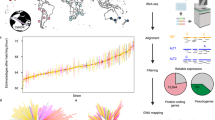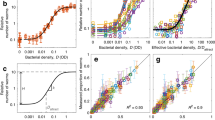Abstract
Innate behaviours are flexible: they change rapidly in response to transient environmental conditions, and are modified slowly by changes in the genome. A classical flexible behaviour is the exploration–exploitation decision, which describes the time at which foraging animals choose to abandon a depleting food supply. We have used quantitative genetic analysis to examine the decision to leave a food patch in Caenorhabditis elegans. Here we show that patch-leaving is a multigenic trait regulated in part by naturally occurring non-coding polymorphisms in tyra-3 (tyramine receptor 3), which encodes a G-protein-coupled catecholamine receptor related to vertebrate adrenergic receptors. tyra-3 acts in sensory neurons that detect environmental cues, suggesting that the internal catecholamines detected by tyra-3 regulate responses to external conditions. These results indicate that genetic variation and environmental cues converge on common circuits to regulate behaviour, and suggest that catecholamines have an ancient role in regulating behavioural decisions.
This is a preview of subscription content, access via your institution
Access options
Subscribe to this journal
Receive 51 print issues and online access
$199.00 per year
only $3.90 per issue
Buy this article
- Purchase on Springer Link
- Instant access to full article PDF
Prices may be subject to local taxes which are calculated during checkout




Similar content being viewed by others
References
Flint, J. & Mackay, T. F. Genetic architecture of quantitative traits in mice, flies, and humans. Genome Res. 19, 723–733 (2009)
Stephens, D. W., Brown, J. S. & Ydenberg, R. C. Foraging: Behavior and Ecology (Univ. Chicago Press, 2007)
Charnov, E. L. Optimal foraging, the marginal value theorem. Theor. Popul. Biol. 9, 129–136 (1976)
March, J. G. Exploration and exploitation in organizational learning. Organ. Sci. 2, 71–87 (1991)
Barrett, H. C. & Fiddick, L. Evolution and risky decisions. Trends Cogn. Sci. 4, 251–252 (2000)
Aston-Jones, G. & Cohen, J. D. An integrative theory of locus coeruleus-norepinephrine function: adaptive gain and optimal performance. Annu. Rev. Neurosci. 28, 403–450 (2005)
Harvey, S. C. Non-dauer larval dispersal in Caenorhabditis elegans . J. Exp. Zool. B 312, 224–230 (2009)
Shtonda, B. B. & Avery, L. Dietary choice behavior in Caenorhabditis elegans . J. Exp. Biol. 209, 89–102 (2006)
Pujol, N. et al. A reverse genetic analysis of components of the Toll signaling pathway in Caenorhabditis elegans . Curr. Biol. 11, 809–821 (2001)
Pradel, E. et al. Detection and avoidance of a natural product from the pathogenic bacterium Serratia marcescens by Caenorhabditis elegans . Proc. Natl Acad. Sci. USA 104, 2295–2300 (2007)
Lipton, J., Kleemann, G., Ghosh, R., Lints, R. & Emmons, S. W. Mate searching in Caenorhabditis elegans: a genetic model for sex drive in a simple invertebrate. J. Neurosci. 24, 7427–7434 (2004)
Gloria-Soria, A. & Azevedo, R. B. npr-1 Regulates foraging and dispersal strategies in Caenorhabditis elegans . Curr. Biol. 18, 1694–1699 (2008)
Styer, K. L. et al. Innate immunity in Caenorhabditis elegans is regulated by neurons expressing NPR-1/GPCR. Science 322, 460–464 (2008)
Reddy, K. C., Andersen, E. C., Kruglyak, L. & Kim, D. H. A polymorphism in npr-1 is a behavioral determinant of pathogen susceptibility in C. elegans . Science 323, 382–384 (2009)
de Bono, M. & Bargmann, C. I. Natural variation in a neuropeptide Y receptor homolog modifies social behavior and food response in C. elegans . Cell 94, 679–689 (1998)
Gray, J. M. et al. Oxygen sensation and social feeding mediated by a C. elegans guanylate cyclase homologue. Nature 430, 317–322 (2004)
Rogers, C., Persson, A., Cheung, B. & de Bono, M. Behavioral motifs and neural pathways coordinating O2 responses and aggregation in C. elegans . Curr. Biol. 16, 649–659 (2006)
Bretscher, A. J., Busch, K. E. & de Bono, M. A carbon dioxide avoidance behavior is integrated with responses to ambient oxygen and food in Caenorhabditis elegans . Proc. Natl Acad. Sci. USA 105, 8044–8049 (2008)
McGrath, P. T. et al. Quantitative mapping of a digenic behavioral trait implicates globin variation in C. elegans sensory behaviors. Neuron 61, 692–699 (2009)
Macosko, E. Z. et al. A hub-and-spoke circuit drives pheromone attraction and social behaviour in C. elegans . Nature 458, 1171–1175 (2009)
Osborne, K. A. et al. Natural behavior polymorphism due to a cGMP-dependent protein kinase of Drosophila . Science 277, 834–836 (1997)
Reaume, C. J. & Sokolowski, M. B. cGMP-dependent protein kinase as a modifier of behaviour. Handb. Exp. Pharmacol. 191, 423–443 (2009)
Hong, R. L., Witte, H. & Sommer, R. J. Natural variation in Pristionchus pacificus insect pheromone attraction involves the protein kinase EGL-4. Proc. Natl Acad. Sci. USA 105, 7779–7784 (2008)
Rockman, M. V. & Kruglyak, L. Recombinational landscape and population genomics of Caenorhabditis elegans . PLoS Genet. 5, e1000419 (2009)
Steinmetz, L. M. et al. Dissecting the architecture of a quantitative trait locus in yeast. Nature 416, 326–330 (2002)
Edwards, A. C. & Mackay, T. F. Quantitative trait loci for aggressive behavior in Drosophila melanogaster . Genetics 182, 889–897 (2009)
Legare, M. E., Bartlett, F. S., II & Frankel, W. N. A major effect QTL determined by multiple genes in epileptic EL mice. Genome Res. 10, 42–48 (2000)
Thomson, M. J., Edwards, J. D., Septiningsih, E. M., Harrington, S. E. & McCouch, S. R. Substitution mapping of dth1. 1, a flowering-time quantitative trait locus (QTL) associated with transgressive variation in rice, reveals multiple sub-QTL. Genetics 172, 2501–2514 (2006)
Wragg, R. T. et al. Tyramine and octopamine independently inhibit serotonin-stimulated aversive behaviors in Caenorhabditis elegans through two novel amine receptors. J. Neurosci. 27, 13402–13412 (2007)
Mackay, T. F. Quantitative trait loci in Drosophila . Nature Rev. Genet. 2, 11–20 (2001)
Bargmann, C. I. & Horvitz, H. R. Chemosensory neurons with overlapping functions direct chemotaxis to multiple chemicals in C. elegans . Neuron 7, 729–742 (1991)
Gray, J. M., Hill, J. J. & Bargmann, C. I. A circuit for navigation in Caenorhabditis elegans . Proc. Natl Acad. Sci. USA 102, 3184–3191 (2005)
Wakabayashi, T., Kitagawa, I. & Shingai, R. Neurons regulating the duration of forward locomotion in Caenorhabditis elegans . Neurosci. Res. 50, 103–111 (2004)
Hallem, E. A. & Sternberg, P. W. Acute carbon dioxide avoidance in Caenorhabditis elegans . Proc. Natl Acad. Sci. USA 105, 8038–8043 (2008)
Zimmer, M. et al. Neurons detect increases and decreases in oxygen levels using distinct guanylate cyclases. Neuron 61, 865–879 (2009)
Frøkjær-Jensen, C. et al. Single-copy insertion of transgenes in Caenorhabditis elegans . Nature Genet. 40, 1375–1383 (2008)
Suo, S., Kimura, Y. & Van Tol, H. H. Starvation induces cAMP response element-binding protein-dependent gene expression through octopamine-Gq signaling in Caenorhabditis elegans . J. Neurosci. 26, 10082–10090 (2006)
Alkema, M. J., Hunter-Ensor, M., Ringstad, N. & Horvitz, H. R. Tyramine functions independently of octopamine in the Caenorhabditis elegans nervous system. Neuron 46, 247–260 (2005)
Greer, E. R., Perez, C. L., Van Gilst, M. R., Lee, B. H. & Ashrafi, K. Neural and molecular dissection of a C. elegans sensory circuit that regulates fat and feeding. Cell Metab. 8, 118–131 (2008)
Pirri, J. K., McPherson, A. D., Donnelly, J. L., Francis, M. M. & Alkema, M. J. A tyramine-gated chloride channel coordinates distinct motor programs of a Caenorhabditis elegans escape response. Neuron 62, 526–538 (2009)
Crocker, A. & Sehgal, A. Octopamine regulates sleep in Drosophila through protein kinase A-dependent mechanisms. J. Neurosci. 28, 9377–9385 (2008)
Roeder, T. Tyramine and octopamine: ruling behavior and metabolism. Annu. Rev. Entomol. 50, 447–477 (2005)
Hoyer, S. C. et al. Octopamine in male aggression of Drosophila . Curr. Biol. 18, 159–167 (2008)
Yalcin, B. et al. Genetic dissection of a behavioral quantitative trait locus shows that Rgs2 modulates anxiety in mice. Nature Genet. 36, 1197–1202 (2004)
Young, L. J., Nilsen, R., Waymire, K. G., MacGregor, G. R. & Insel, T. R. Increased affiliative response to vasopressin in mice expressing the V1a receptor from a monogamous vole. Nature 400, 766–768 (1999)
Mackay, T. F., Stone, E. A. & Ayroles, J. F. The genetics of quantitative traits: challenges and prospects. Nature Rev. Genet. 10, 565–577 (2009)
Gerke, J., Lorenz, K., Ramnarine, S. & Cohen, B. Gene-environment interactions at nucleotide resolution. PLoS Genet. 6, e1001144 (2010)
Ramot, D., Johnson, B. E., Berry, T. L., Jr, Carnell, L. & Goodman, M. B. The Parallel Worm Tracker: a platform for measuring average speed and drug-induced paralysis in nematodes. PLoS ONE 3, e2208 (2008)
Broman, K. W., Wu, H., Sen, S. & Churchill, G. A. R/qtl: QTL mapping in experimental crosses. Bioinformatics 19, 889–890 (2003)
Mello, C. & Fire, A. DNA transformation. Methods Cell Biol. 48, 451–482 (1995)
Hobert, O. PCR fusion-based approach to create reporter gene constructs for expression analysis in transgenic C. elegans . Biotechnique 32, 728–730 (2002)
Ahringer, J. Reverse genetics. In WormBook (ed. The C. elegans Research Community) doi:10.1895/wormbook.1.47.1 (6 April 2006); available at 〈http://www.wormbook.org〉.
Troemel, E. R., Chou, J. H., Dwyer, N. D., Colbert, H. A. & Bargmann, C. I. Divergent seven transmembrane receptors are candidate chemosensory receptors in C. elegans . Cell 83, 207–218 (1995)
Bargmann, C. I. & Avery, L. Laser killing of cells in Caenorhabditis elegans . Methods Cell Biol. 48, 225–250 (1995)
Chelur, D. S. & Chalfie, M. Targeted cell killing by reconstituted caspases. Proc. Natl Acad. Sci. USA 104, 2283–2288 (2007)
Kim, K. et al. Two chemoreceptors mediate developmental effects of dauer pheromone in C. elegans . Science 326, 994–998 (2009)
Acknowledgements
We thank R. Shingai for strains, and P. McGrath and members of the C.I.B. laboratory for discussions. A.B. was supported by the Secretaría de Educación Pública of Mexico and by The Rockefeller University. C.I.B. and L.K. are Investigators of the Howard Hughes Medical Institute. This work was supported by HHMI and by NIH grant GM089972.
Author information
Authors and Affiliations
Contributions
A.B. and C.I.B. designed experiments, A.B. conducted experiments, M.V.R. constructed strains for QTL mapping, M.T. developed tracking methods, A.B., M.V.R., L.K. and C.I.B. analysed and interpreted results, and A.B. and C.I.B. wrote the paper.
Corresponding author
Ethics declarations
Competing interests
The authors declare no competing financial interests.
Supplementary information
Supplementary Information
The file contains Supplementary Figures 1-10 with legends, Supplementary Table 1, Supplementary Methods, Strain List and additional references. (PDF 6105 kb)
Supplementary Movie 1
This movie shows leaving assay showing six N2 adults, 20x actual speed. The border of the bacterial lawn is outlined for ease of visualization. Time stamp at upper left displays the actual time after placing the animals on the assay plate. (MOV 8791 kb)
Supplementary Movie 2
This movie shows leaving assay showing six HW adults, 20x actual speed. Four animals are on the lawn and two off the lawn at the beginning of the assay. The border of the bacterial lawn is outlined for ease of visualization. Time stamp at upper left displays the actual time after placing the animals on the assay plate. (MOV 8791 kb)
Rights and permissions
About this article
Cite this article
Bendesky, A., Tsunozaki, M., Rockman, M. et al. Catecholamine receptor polymorphisms affect decision-making in C. elegans. Nature 472, 313–318 (2011). https://doi.org/10.1038/nature09821
Received:
Accepted:
Published:
Issue Date:
DOI: https://doi.org/10.1038/nature09821
This article is cited by
-
Sexual morph specialisation in a trioecious nematode balances opposing selective forces
Scientific Reports (2022)
-
Connectivity adaptations in dopaminergic systems define the brain maturity of investors
Scientific Reports (2021)
-
Olfactory receptor and circuit evolution promote host specialization
Nature (2020)
-
A multi-parent recombinant inbred line population of C. elegans allows identification of novel QTLs for complex life history traits
BMC Biology (2019)
-
Bounded rationality in C. elegans is explained by circuit-specific normalization in chemosensory pathways
Nature Communications (2019)
Comments
By submitting a comment you agree to abide by our Terms and Community Guidelines. If you find something abusive or that does not comply with our terms or guidelines please flag it as inappropriate.



